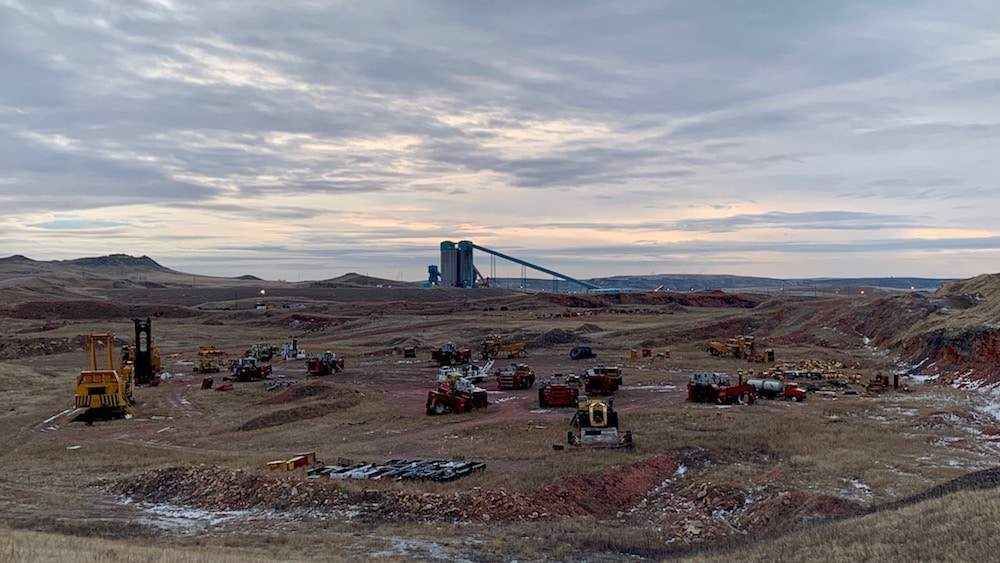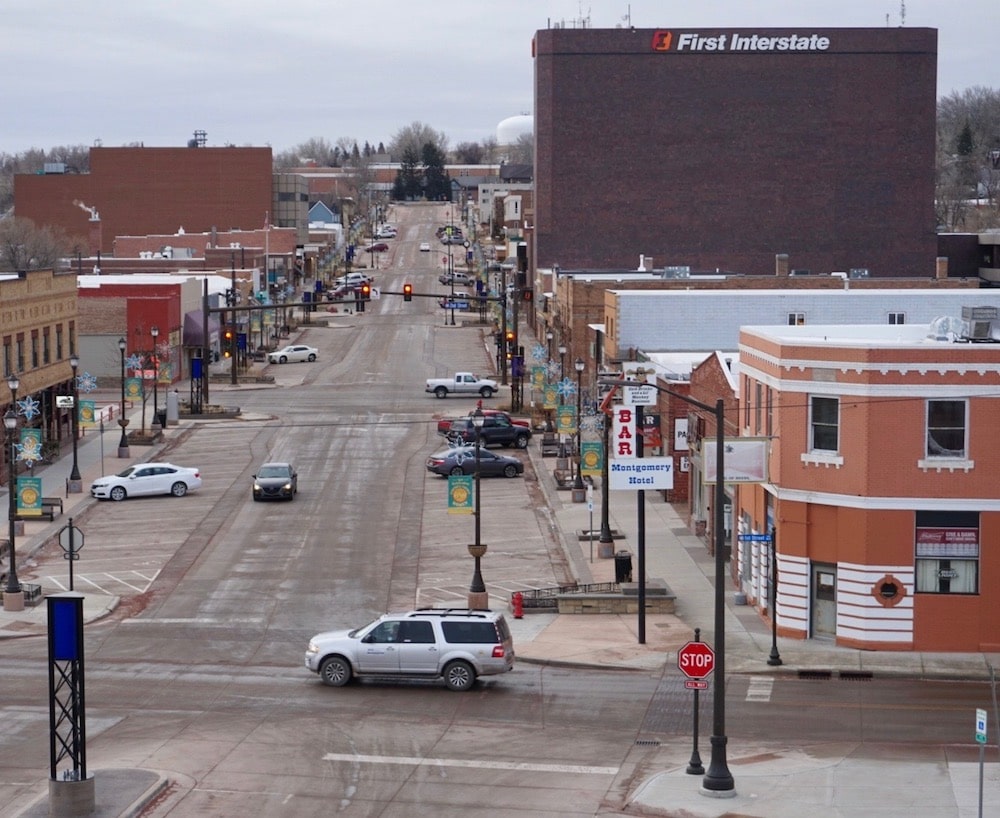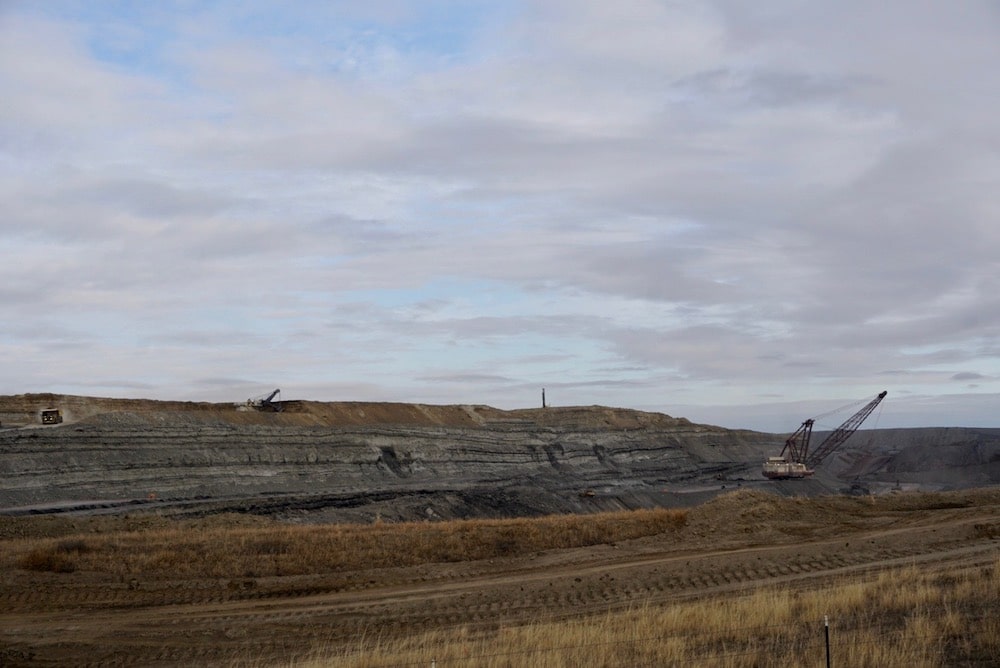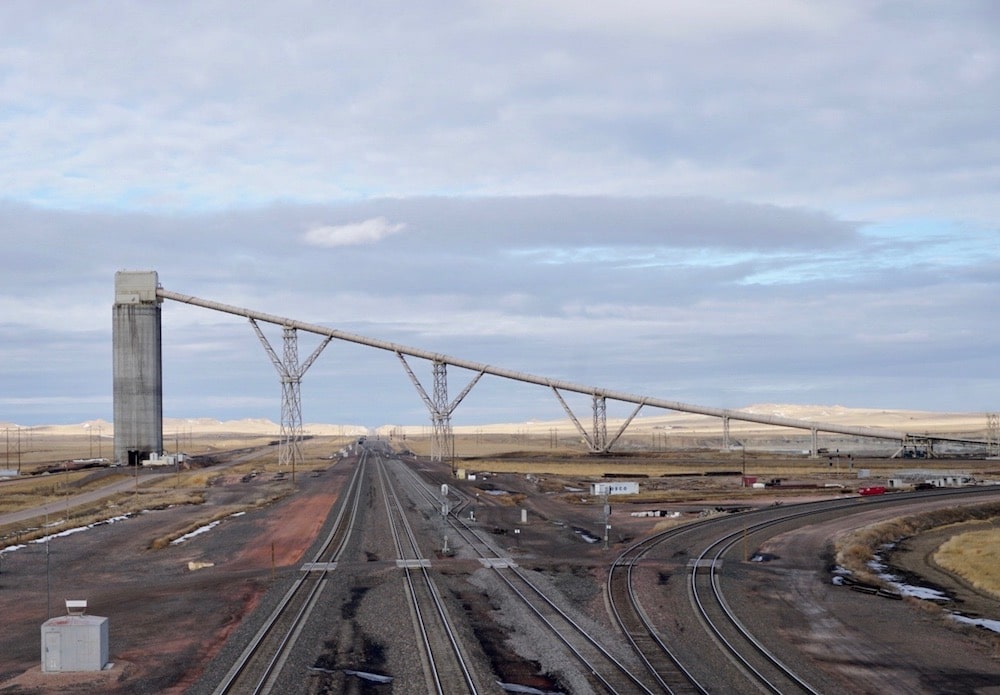Is PRB Coal Headed for Gradual Decine or Sheer Cliff?

By Dustin Bleizeffer
January 7, 2020 - Despite the continuing downturn in U.S. coal and a bruising series of bankruptcies, there’ve been no recent permanent mine closures in the Powder River Basin.
It’s a surprising outcome for a region that’s lost nearly 35% of its coal production and hundreds of jobs in the span of 10 years. Even the Eagle Butte and Belle Ayr mines resumed operations after a 2019 bankruptcy resulted in temporary closures, offering some sense of stability in a region heavily dependent on coal mining.
The reprieve, however, may be short-lived.
The federal Energy Information Administration recently downgraded its coal production forecast, and an October report by Moody’s titled “Powder River Basin remains distressed” noted that the basin is over-capacity and due for a correction. “We expect that at least a few PRB mines will close in the early 2020s,” the report’s authors wrote.
Perhaps most troubling for Wyoming miners and taxpayers is that the dire projections for Wyoming’s thermal coal don’t account for new vulnerability to risks that previously wouldn’t have posed as much of a threat.
Nobody knows for sure whether the nation’s largest coal complex, the Powder River Basin, might wind down gradually over a decade-plus, or rapidly over a few short years. Given the increasingly precarious market and policy forces reshaping the industry, some analysts say they can’t rule out the possibility that Powder River Basin production could even careen over a cliff.
“I agree that the Powder River Basin is not going to ride a gentle glidepath into oblivion decades from now,” Headwaters Economics Research Director Mark Haggerty said. “More likely, markets or policy will cross thresholds where things begin to happen very quickly. We may be in that now, or it could still be off in the future. But likely not far.”

This “bone yard” at the Eagle Butte coal mine north of Gillette is filled with old mining equipment. Eagle Butte was one of several coal mines to temporarily close in 2019 due to Blackjewel’s bankruptcy. Both Eagle Butte and the Belle Ayr mine in Wyoming’s Powder River Basin went back to work after Blackjewel’s sale to Eagle Specialty Materials was approved in October.
Photo: Dustin Bleizeffer
While Wyoming lawmakers only begin to grapple with how to better protect miners and taxpayers in bankruptcies and layoffs, many are also beginning to recognize that this may be a permanent foundational change.
“Cynics might suggest that Wyoming is accustomed to boom-and-bust cycles and we need only wait for the markets to turn around,” Gov. Mark Gordon stated in his budget letter to lawmakers in November. “This time though, we may well be experiencing a more fundamental change.”
How quickly that fundamental change occurs is critical to communities throughout the state as they plan for a future that many had never imagined — one without a giant coal mining engine to buoy the ups and downs of a volatile mineral extraction-dependent economy.
New era of risk
Wyoming leaders are familiar with both the projections that point toward fundamental changes for coal, and the root causes — primarily that policies and markets continue to push utilities away from the Powder River Basin’s thermal supply and toward natural gas and renewables:
- Following a bruising 8% decline in U.S. coal production last year, the U.S. Energy Information Administration forecasts a 14% decline in 2020, and “continued idling and closures of mines as a result of declining domestic demand.”
- “EIA forecasts the share of U.S. electric generation from coal to average 25% in 2019 and 22% in 2020, down from 28% in 2018.” In the early 2000s, thermal coal’s share of electric generation was slightly more than 50%.
- From 2008 to 2018, coal production in the Powder River Basin declined nearly 35%, according to EIA.
- Projected declines for Powder River Basin coal production range from 9% (26 million tons) to 36% (107 million tons) through 2028.
Although bleak, the projected downward trajectory might be interpreted as gradual. But what the data doesn’t show are the many new vulnerabilities of a diminishing Powder River Basin coal industry that might further contribute to a decline, or how a continually shrinking market might play out here in Wyoming.
“The new normal now is actually decline,” said Clark Williams-Derry, energy finance analyst for the Institute for Energy Economics and Financial Analysis. “The normal now is probably a bad year, then a so-so year, and then a bad year. It’s not like, ‘OK, we’ve stabilized at a slightly lower level, we can kind of recalibrate our economy and go on a steady stage from here.’ I don’t think that’s a realistic hope anymore.”
The 2020 elections also pose significant uncertainty for the coal industry — including at the state and regional levels. And no matter the election outcomes, Williams-Derry said, an expectation exists in the financial markets that sweeping policies to reduce carbon emissions — whether implemented nationally or by region — are inevitable. Investors and big banks have already begun swearing off coal, representing an essential threat that is a lot less predictable than, say, a schedule of future coal-fired power plant closures.
Last month, Goldman Sachs became the first major U.S. Bank to announce it will phase out financing for future thermal coal projects.
“Financing could be a tipping point,” said Rob Godby, director of the University of Wyoming’s Center for Energy Economics and Public Policy. “It’s not out of the question to imagine a sudden decline in credit being available and that having significant stresses in the basin.”
Industry analysts also point to potential technology breakthroughs for battery storage that could further boost renewables over coal in the electrical power sector.

Gillette has long served as the hub of the Powder River Basin coal complex, which supplies about 40% of the nation’s thermal coal for power generation. Mine workers and local businesses have scrambled to adjust to a coal industry downturn that may only get worse.
Photo: Dustin Bleizeffer
Still, the primary and most predictable force working against Wyoming coal is the continuing market loss due to the retirement of coal-fired power plants — which are a significant source of greenhouse gases driving climate change. This only compounds the many other risks, and how it shapes the Powder River Basin depends on the financial strength of individual mines and mining companies, analysts say.
“It’s hard to see how there might be a rebound that’s going to be good enough for the coal economy for a lot of these [Powder River Basin] mines to stabilize, let alone get back to where they used to be,” said Williams-Derry.
Winners and losers in the PRB
Now that the pool of Powder River Basin customers has shrunk, future coal plant closures will likely hit particular mines and mining companies harder than others, according to UW’s Godby, and some might not be able to weather the losses.
“We’re kind of at that stage in the downturn where particular retirements could be particularly impactful in the Powder River Basin,” Godby said.
Godby is collaborating with Haggerty of Headwaters Economics to map how scheduled coal plant closures might impact individual mines in the basin. For example, the closure of a plant that burns 5 million tons of coal annually might have a negligible effect if the lost tonnage is spread among several PRB mines, Godby said, or it might have a devastating effect if the loss hits one particular mine or economically prone operator.
There are 33 coal-fired power plants that each account for 1% or more of Powder River Basin production, Godby said. Though only a few are currently scheduled for retirement, plans can change quickly in the U.S. electricity generation market. Powder River Basin mines that are “overly exposed” to the future of these key 33 plants include Eagle Butte, Coal Creek, Belle Ayr, Cordero Rojo and Caballo, according to Godby.
Godby and Haggerty plan to release the full report later this month.
A scramble for efficiencies, consolidation
The uncommonly thick and shallow coal seams in Wyoming’s Powder River Basin are among the cheapest in the world to mine. That cost-to-mine advantage, Godby said, only plays out at scale — operators have to make big investments in capacity and produce large volumes of coal to make it pay.
After several years of decline, the basin is operating “over capacity” as mines try to reap those large economies of scale — working desperately to find efficiencies via layoffs, attrition and renting rather than owning equipment, analysts agree. The question is, how long until some mines reach a breaking point?

A dragline swings dirt to expose coal at a surface mine in the southern Powder River Basin, while truck-and-shovel crews remove overburden from benches above the operation.
Photo: Dustin Bleizeffer
“We’ve got the same number of mines chasing fewer and fewer customers,” Godby said. “That is not sustainable … Some mines are going to have to close.”
Collectively, Powder River Basin mines had an annual operational capacity of 476 million tons in 2018. Shrinking customer demand supports an ever shrinking portion of that capacity — only 68% in 2018, potentially even less in 2019, and still less in 2020, according to EIA data and projections.
“That over-capacity is leading to greater costs. It’s reducing profitability because they [Powder River Basin mines] have no power over price,” Godby said.
Godby said he doesn’t envision a tipping point where dwindling demand suddenly pushes the entire Powder River Basin over a cliff. Rather, the basin is likely to see a scramble to find efficiencies that results in fewer mining companies and some mines closing.
“Eventually, somebody’s got to fail,” Godby said. “That takes care of those smaller, less efficient mines. And so what you’re left with are larger mines taking over what’s left of that demand, and moving to more efficient technology.”
A new ‘super mine’
A proposal by Arch Coal and Peabody Energy to merge their western mining operations is a result of this new era of competition and efficiency.
Both corporations recently shed billions in debt via bankruptcy, and both operate sprawling mining complexes adjacent to one another in the southern portion of the Powder River Basin. Together, Arch’s Black Thunder and Peabody’s neighboring North Antelope Rochelle mine make up nearly two-thirds of all coal production in the basin. By merging these mines, and the companies’ other smaller western operations, Arch and Peabody expect to trim costs by $120 million annually.

A coal conveyor stretches over rails to a loadout facility at Arch Coal’s Black Thunder mine in the southern Powder River Basin. Arch Coal and Peabody Energy propose merging their adjacent mining operations here, which make up two-thirds of all coal production in the Wyoming portion of the basin.
Photo: Dustin Bleizeffer
If approved, the operations merger would also boost the companies’ access to financial markets — critical to investing in the facilities and fleets of equipment required to mine coal seams that slant deeper into the earth. The Arch-Peabody merger — pending federal approval and possible court challenges — would galvanize the companies’ domination in the Powder River Basin, observers say.
“The way everyone is reading the joint venture is they [Arch and Peabody] are going to be the last two standing,” said Shannon Anderson, attorney for the landowner advocacy group Powder River Basin Resource Council. “They are the two publicly traded entities out there with the most to win or lose with investors, so the public eye is going to be on them more than some of these other companies.”
Collectively, Arch and Peabody mines in the basin have the advantage of a diverse portfolio of power plant customers, Godby said. The internal and logistic efficiencies gained by merging operations — along with the fact that both corporations have shed billions in debt — give Arch and Peabody a powerful advantage in attracting capital. Continuing investments in equipment, labor and other critical operations are necessary to preserve profit margins at economies of scale as the mines carve deeper into the basin.
Arch and Peabody’s advantage via the proposed operations merger, Godby said, only adds more pressure on smaller mines and mining companies in the basin.
“It’s not like the coal market is growing, so it’s a zero-sum game for the PRB. It’s pretty cutthroat competition right now.”
Diminishing lifelines and worst-case scenarios
Despite a continuing uptick in coal consumption globally, analysts don’t expect a breakthrough in seabound exports for Wyoming coal. The price volatility of Asian markets doesn’t play well with increasingly tight profit margins in Powder River Basin coal. Also, coal producers in Montana and Utah are first in line, before Wyoming, to benefit from potential increases in West Coast exports, industry analysts say.
“The thing is, from time to time, Asian exports really have been lucrative,” Williams-Derry said. “Even PRB exports. It just never lasts long. Economically, it makes sense for PRB companies to dip into and out of those markets, if they can.”
But unfortunately for producers in Wyoming, Williams-Derry added, railroads and seaport terminals demand long-term contracts that expose coal companies to wild price swings. “Coal companies that have banked on export markets have taken a bath, over and over again. Seaborne coal prices are just too volatile,” he said.
Coal market analysts also aren’t holding out hope that advances in technologies to reduce coal’s carbon footprint will have significant success in slowing the downward trajectory for Wyoming’s thermal coal market.
“There is a real concern here that you are raising false hopes,” Godby told the Casper Star-Tribune. “Carbon capture will not arrest the transition that is going on. It potentially creates a use for some of the coal and some of the facilities that we have in the state in the future, but we’re still looking at a whole heap of (coal) closures — whether they are mines or power plants — before that technology is widely implemented.”
Though coal proponents have the backing of the Trump administration and Wyoming’s elected leaders to enact pro-coal policies and promote technologies aimed to help preserve the state’s thermal coal legacy, their efforts have done little to turn the tide that is transforming Wyoming’s coal industry. Even if the Powder River Basin reorganizes into a slimmer, more financially-resilient mining complex, it remains prone to myriad risks that rob Wyoming communities of any sense of certainty regarding how much time they might have to adjust to a new future.
Godby’s report to Wyoming lawmakers in November summarized the state’s coal industry predicament: “Coal production will not recover in [the] next five years – question is how bad it gets[?]”

